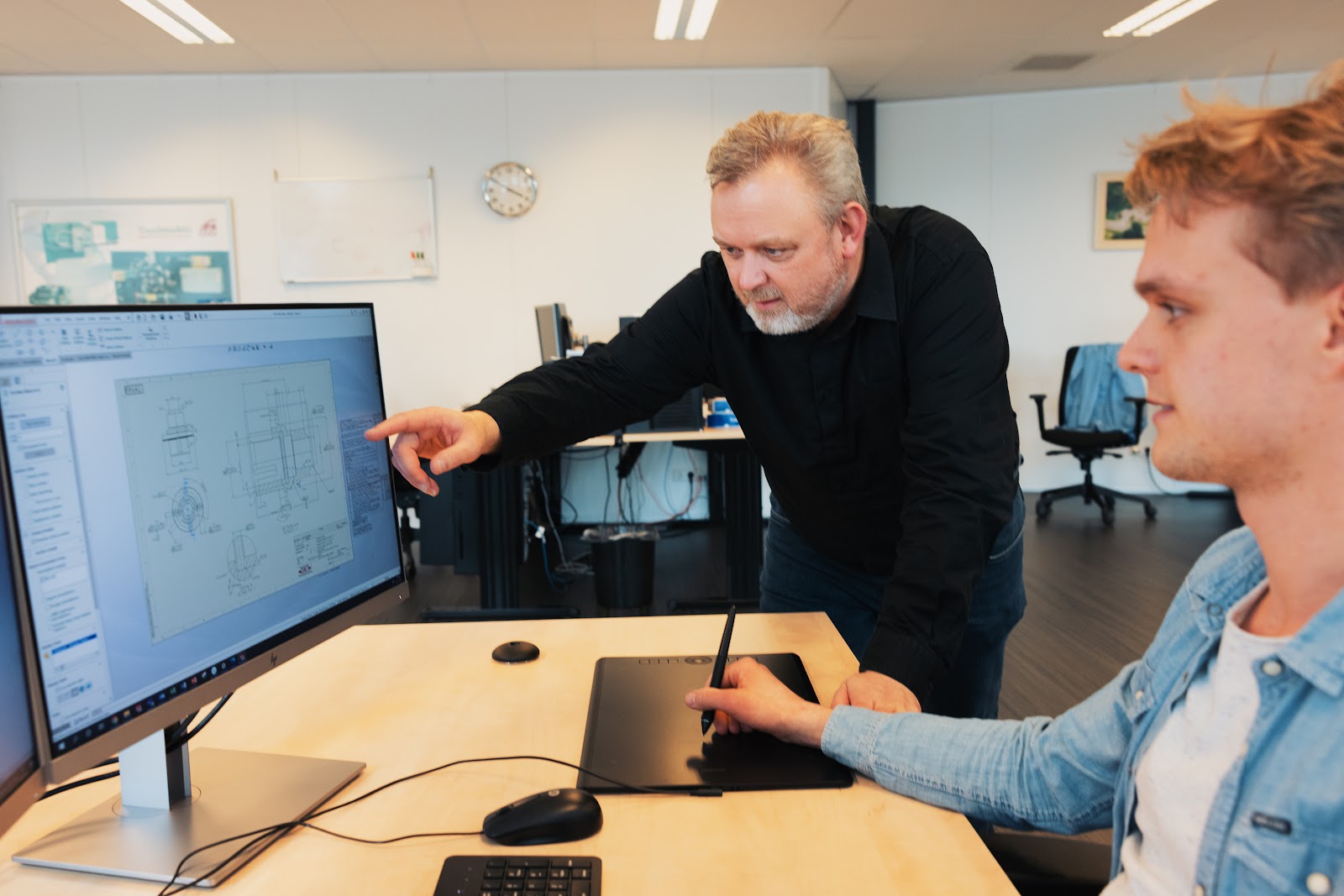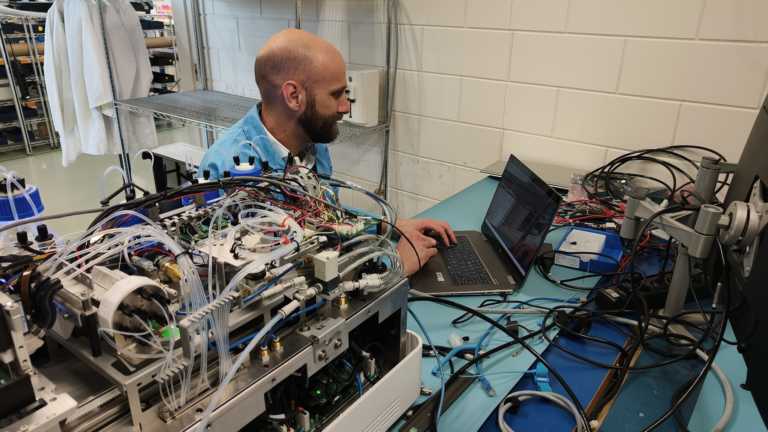
Trial and Error: The Long and Winding Road of Developing Your Idea into an Approved and Certified Medical Device
Let’s say you have an idea for a ground-breaking new medical device. You know what it must do, but you don’t know how to go about developing it. That’s where Technobis enters the frame. When developing a medical device for series production, there are a number of fixed procedures to complete.
Depending on the complexity of your product, the process of development from idea to market may take as long as two or more years. At Technobis, we distinguish at least five stages to go from just an idea through the design and development stage, towards certification, clinical tests, and the eventual goal, used by medical professionals or in home healthcare.
Surveying User, Technical, and Software Requirements

The first step is staking out the various parameters that you want your device to answer to. In other words, the functionalities, properties and uses of your device. These are your user requirements. We then translate these into a set of system requirements. For instance, when you say that the device may not become too hot to conveniently hold in hand, we must translate that into a more precise and measurable description, such as “Device X may not exceed a surface temperature of 40 degrees Celsius
We weigh all system requirements against quality standards we have defined in the regulatory strategy plan for the medical device.
As your future device will be used for helping humans, Risk assessment is essential in establishing design requirements. When a device’s purpose is to help surgeons perform surgery, a possible risk could be infections. One way to eliminate that risk is using materials for your device that prevent infections and are easy to sterilise.
Surveying all requirements beforehand serves to eliminate risks and save time, as well as a streamlined time-to-market. All these requirements are carefully documented, as well as the processes in the next steps.
Sub-level prototyping
Sub-level prototyping is an essential part of our initial design stages, and an iterative process. As your medical device may be a completely new instrument, our engineers must design specific complex parts that solve specific problems, and have not been developed before.
To make sure that their ideas work as planned and that they work both sustainably and cost-effectively, our engineers can develop complex parts of their design by using our workshop facilities or with the help of our partners. It allows them to test components’ properties and if needed, make design adjustments. For instance, we can quickly fine-tune physical parameters such as surface roughness, geometry, tolerances and strength. This stage mitigates the number of variables in the next prototyping phase.
The first step is staking out the various parameters that you want your device to answer to. In other words, the functionalities, properties and uses of your device. These are your user requirements. We then translate these into a set of system requirements. For instance, when you say that the device may not become too hot to conveniently hold in hand, we must translate that into a more precise and measurable description, such as “Device X may not exceed a surface temperature of 40 degrees Celsius
We weigh all system requirements against quality standards we have defined in the regulatory strategy plan for the medical device.
As your future device will be used for helping humans, Risk assessment is essential in establishing design requirements. When a device’s purpose is to help surgeons perform surgery, a possible risk could be infections. One way to eliminate that risk is using materials for your device that prevent infections and are easy to sterilise.
Surveying all requirements beforehand serves to eliminate risks and save time, as well as a streamlined time-to-market. All these requirements are carefully documented, as well as the processes in the next steps.
Creating Designs Based on All Requirements

Based on these requirements, our engineers create mechanical, electrical and software designs. Together, they form the blueprints for your device. Naturally, depending on your device’s complexity, novelty and intended use, the design stage may or may not require multiple iterations and partial prototyping.
For future certification, all design options and tests are recorded into a Design History File (DHF).
Prototyping Your Device
When the design is approved and in theory meets all previously compiled requirements, it is time to start producing a working model of your new device; a prototype. This is where we need a Device manufacturing Record (DMR), which can be regarded as a manual or cookbook for creating your device. It includes all steps for building your device, including information on supply chain, purchasing, quantities, and assembly and test manuals. It also includes the design layouts, schedules, and software code.
To make sure we can easily trace devices, we create a Device History Record (DHR). It contains all manufacturing and tracking documents, including serial and lot numbers for critical components. If a manufacturer of a critical components reports a malfunction, we know exactly which devices will have to be recalled for replacement of the component.
Recording and documenting all data at all times is required to get your product approved and certified more quickly.
Requirements Test
Part of the prototyping process is testing if and how your device meets all the predetermined requirements. This is another required protocol to make the device go through the next phase as smoothly as possible.
External Testing in CE Test Labs
If the device meets all the functional system requirements, we send a pre-production device to a certified laboratory for CE testing. They follow strict procedures too, as recorded in the regulatory strategy plan. Among quite a few other things, they test for strength and durability, low voltage and EMC performance, heavy impact, and user and patient safety.
A device with moving parts, for instance, should be safe to use without the risk of getting your fingers caught between them. How does accidentally dropping the device to the floor affect its performance? Does it create hazardous situations? Or can you simply pick it up and continue what you were doing? How does it perform under wet or moist circumstances? How easily can it be sterilised?
Another important one is the usability test. If your device is typically used in tense emergency situations, it must be able to be used intuitively. For instance, if it has an operation screen, there shouldn’t be too many confusing options and functionalities.
There are numerous protocols in place to make sure that your device is tested thoroughly and for every possible scenario.
Clinical Trials
When everything checks out technically, it’s time to validate the device’s user requirements and processes. This can be done through one or more clinical trials, in which medical specialists use the device in a controlled real-life setting.
After the validation, we combine all reports with the technical CE documents and send them to a Notified Body for CE Certification. They review whether we followed the correct procedures to develop your medical device and if we provided sufficient evidence to prove it.
They check, among others, for correct usage of standards, requirements, design decisions, as well as verification and validation. What considerations went into the device, and how risk management was handled. How the various requirements were translated into system requirements, and the hows and whys of the production process.
This is why we make sure to compile all the files during the whole process of development.
Final step: Design Transfer
When all of the above has been approved and certified, we transfer the design to production, including the documentation detailing how the device should be produced. This is where your device becomes a fully functional, series product, ready to be used in a medical setting on a daily basis.
Are you looking for a capable partner who can help you develop your idea into a medical device that improves healthcare and medicinal practices? Benefit from our years of expertise, and contact us today to start your venture.




